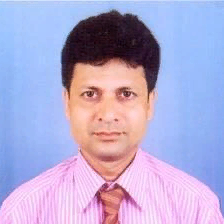
Rajib Bag
Work place: Supreme Knowledge Foundation Group of Institutions, Mankundu, Hooghly, India
E-mail: rajib.bag@gmail.com
Website:
Research Interests: Control Theory, Image Processing, Computer Architecture and Organization, Computer systems and computational processes
Biography
Dr. Rajib Bag was born in 1969, received his B.Sc (Physics Hons.) from Calcutta University, M.Sc. (Physics) from Vinoba Bhave University and M.Tech. and Ph.D (Engg.) from Jadavpur University, India in the year of 1991, 1996, 2007 and 2012 respectively. His doctoral work was in the field of control systems. Presently, he is working as a Professor and Head in the department of Computer Science and Engineering at Supreme Knowledge Foundation Group of Institutions under West Bengal University Technology, Mankundu, Hooghly, West Bengal, India. He has more than 20 publications in reputed refereed journals and conference proceedings to his credit. His research interest includes image and signal processing and education technology besides control systems.
Author Articles
Mobile Phone Ranking by Analytical Hierarchical Process: A Case Study
By Kaustuv Deb Rudra Prasad Chatterjee Sonali Banerjee Rajib Bag Atanu Das
DOI: https://doi.org/10.5815/ijieeb.2018.06.06, Pub. Date: 8 Nov. 2018
Mobile phones are one of the highly used gadgets now a day. These handheld devices serve multiple purposes through different available functionalities. Demand of services and functionalities vary with time and person concern. Before purchasing a new mobile phone, one has to judge specifications like functionalities, hardware capabilities and efficiencies available with the particular model of the device. We often find it difficult to identify or decide the best model among the available multiple alternatives by heuristics quick analysis of the specifications and prices.
This paper proposes a method for ranking mobile phone models based on Analytical Hierarchical Process (AHP), one of the typically used mathematical models for Multi Criteria Decision Making (MCDM) problems. The effectiveness of the proposed method is analyzed through a case study consisting of various sophisticated approaches based on AHP. A novice mobile phone buyer will be benefitted by the use of the proposed method incorporated through e-commerce sites.
A Relook and Renovation over State-of-Art Salt and Pepper Noise Removal Techniques
By Aritra Bandyopadhyay Shubhendu Banerjee Atanu Das Rajib Bag
DOI: https://doi.org/10.5815/ijigsp.2015.09.08, Pub. Date: 8 Aug. 2015
Salt and pepper noise is a type of impulse noise, where certain amount of black and white dots appear in the image. The intensity is accumulated in 8 bit integer, giving 256 possible gray levels in the range (0 – 255).In this range salt and pepper noise takes either minimum or maximum intensity. Positive impulse appears as white (salt) points with intensity '255' and negative impulse appears as black (pepper) points with intensity '0' respectively. Salt and pepper noise removal is not an easy task mostly when noise density in the contaminated image is high and restoration of image quality is essential. Different filters like MF, SMF, AMF, PSMF, DBA, DBUTMF, and MDBUTMF and so on are noticed useful for taking away low, moderate and high density salt and pepper noise. The purpose of this paper is to present these filters first and then revise their art to enhance their performances and usefulness. The comparison shows that some of these filters are very fruitful in some particular noise density levels and hence classified applications on these situations are recommended based on the output of investigations.
[...] Read more.Other Articles
Subscribe to receive issue release notifications and newsletters from MECS Press journals